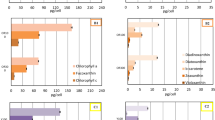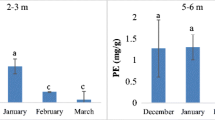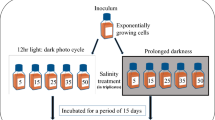Abstract
Dinoflagellates form a large group of microalgae that have different pigments and the pigment content can vary depending on environmental conditions such as temperature, salinity, and their growth phase. They have the potential to cause red tides in coastal waters, so it is important to identify their pigments. In this study, two bloom forming dinoflagellate species, Scrippsiella trochoidea and Gyrodinium instriatum from the Oman Sea, were studied for their pigment content by HPLC every 5 days over a 30-day growth period. In both species, 10 pigment types were identified: unknown carotenoids, chlorophyll (chl) c2, peridinin, peridinin-like, diadinochrome, diadinoxanthin, dinoxanthin, diatoxanthin, chl a, and β,β-carotene. Although both species have the same pigment types, they vary in concentration in different days of growth. The highest cell density in S. trochoidea species was on day 15 of the growth period and the predominant pigments were chl c2, diadinoxanthin, and chl a. Peridinin, peridinin-like, diadinochrome, and β,β-carotene were predominant pigments on day 10, before the cell reached its maximum density. In G. instriatum, the highest cell density during the growth period was in day 10. The highest levels of unknown carotenoids, chl c2, diadinoxanthin, dinoxanthin, peridinin, peridinin-like, diadinochrome, and β,β-carotene pigments were measured on day 25 of growth. The type of chloroplast in both species was the peridinin type. In interpreting the pigment concentration and type, the age of the species should be considered.





Similar content being viewed by others
References
Aminot A, Rey F (2000) Standard procedure for the determination of chlorophyll a by spectroscopic methods. International Council for the Exploration of the Sea. Copenhagen (Denmark)
Ben-Amotz A, Avron M (1983) On the factors which determine massive beta-carotene accumulation in the halotolerant algae Dunaliella bardawil. J Plant Physiol 72:593–597
Bjørnland T, Tangen K (1979) Pigmentation and morphology of a marine Gyrodinium (Dinophyceae) with a major carotenoid different from peridinin and fucoxanthin. J Phycol 15:457–463
Cerón-García MG, Gonzàlez-López CV, Camacho-Rodríguez J, López-Rosales L, García-Camacho F, Molina-Grima E (2018) Maximizing carotenoid extraction from microalgae used as food additives and determined by liquid chromatography (HPLC). Food Chem 257:316–324
Chaneva G, Furnadzhieva S, Minkovq K, Lukavsky J (2007) Effect of light and temperature on the cyanobacterium Arthronema africanum-a prospective phycobiliprotein-producing strain. J Appl Phycol 19:537–544
Chang FH, Gall M (2013) Pigment composition and toxic effects of three harmful Karenia species, Karenia concordia, Karenia brevisulcata and Karenia mikimotoi (Gymnodiniales, Dinophyceae), on rotifers and brine shrimps. Harmful Algae 27:113–120
Gibson G, Carlson R, Simpson J, Smeltzer E, Gerritson J, Chapra S, Heiskary S, Jones J, Kennedy R (2000) Nutrient criteria technical guidance manual lakes and reservoirs. EPA-822-B00-001
Guillard RRL (1975) Culture of phytoplankton for feeding marine invertebrates. In: Smith WL, Chanley MH (eds) Culture of Marine Invertebrate Animals. Plenum Press, New York, pp 26–60
Hallegraeff GM, Anderson DM, Cembella AD, Enevoldsen HO (eds) (2004) Manual on harmful marine microalgae. 2nd revised edition, UNESCO Publishing Paris,. (Monographs on Oceanographic Methodology, 11). 793pp
Jeffrey SW, Humphrey GF (1975) New spectrophotometric equations for determining chlorophylls a, b, c1 and c2 in higher plants, algae and natural phytoplankton. Biochem Physiol Pflanzen (BPP) 167:191–194
Jeffrey SW, Mantoura RFC, Wright SW (1997) Phytoplankton pigments in oceanography: guidelines to modern methods, UNESCO Publishing, Paris
Mercadante AZ, Egeland ES (2004) Carotenoids. In: Britton G, Liaaen-Jensen S, Pfander H (eds) Carotenoids Handbook. Birkhauser Verlag, Basel, pp 230–244
Moheimani NR, Borowitzka MA, Isdepsky A, Fon Sing S (2013) Standard methods for measuring growth of algae and their composition. In: Borowitzka MA, Moheimani NR (eds) Algae for biofuels and energy. Springer, Dordrecht, pp 265–284
Montero L, Sedghi M, Garcia Y, Almeida C, Safi C, Engelen-Smit N, Cifuentes A, Mendiola JA, Ibanez E (2018) Pressurized liquid extraction of pigments from Chlamydomonas sp and chemical characterization by HPLC-MS/MS. J Anal Test 2:149–157
Nascimento SM, Purdie DA, Morris S (2005) Morphology, toxin composition and pigment content of Prorocentrum lima strains isolated from a coastal lagoon in southern UK. Toxicon 45:633–649
Reñé A, Satta CT, Garcés E, Massana R, Zapata M, Anglés S, Camp J (2011) Gymnodinium litoralis sp nov (Dinophyceae), a newly identified bloom-forming dinoflagllate from the NW Mediterranean Sea. Harmful Algae 12:11–25
Serive B, Nicolau E, Bérard JB, Kaas R, Pasquet V, Picot L, Cadoret JP (2017) Community analysis of pigment patterns from 37 microalgae strains reveals new carotenoids and porphyrins characteristic of distinct strains and taxonomic groups. Plos One 12:e0171872
Smith BM, Morrissey PJ, Guenther JE, Nemson JA, Harison MA, Allen JF, Melis A (1990) Response of the photosynthetic apparatus in Dunaliella salina (green alga) to irradiance stress. J Plant Physiol 93:1433–1440
Smith K, Webster L, Bresnan E, Fraser S, Hay S, Moffat C (2007) A review of analytical methodology used to determine phytoplankton pigments in the marine environment and the development of an analytical method to determine uncorrected chlorophyll a, corrected chlorophyll a and phaeophytin a in marine phytoplankton. Fisheries Research Services Internal Report No 03/07 Fisheries Research Services Marine Laboratory Victoria Road, Aberdeen AB11 9DB
Taylor FJR, Hoppenrath M, Saldarriaga JF (2008) Dinoflagellate diversity and distribution. Biodivers Conserv 17:407–418
Wong CK, Wong CK (2003) HPLC pigment analysis of marine phytoplankton during a red tide occurrence in Tolo Harbour, Hong Kong. Chemosphere 52:1633–1640
Wong CK, Wong CK (2009) Characteristics of phytoplankton community structure during and after a bloom of the dinoflagellate Scrippsiella trochoidea by HPLC pigment analysis. J Ocean Univ China 8:141–149
Yamada N, Tanaka A, Horiguchi T (2015) Pigment compositions are linked to habitat types in dinoflagellates. J Plant Res 128:923–932
Zapata M, Fraga S, Rodríguez F, Garrido JL (2012) Pigment-based chloroplast types in dinoflagellates. Mar Ecol Prog Ser 465:33–52
Zhang Q, Liu G, Hu Z (2011) Morphological differences and molecular phylogeny of freshwater blooming species, Peridiniopsis ssp. (Dinophyceae) from China. Eur J Protistol 47:149–160
Zhang Q, Liu G, Hu Z (2014) Description of a new freshwater bloom-forming dinoflagellate with a diatom endosymbiont, Peridiniopsis minima sp. nov. (Peridiniales, Dinophyceae) from China. Algol Stud 146:119–133
Acknowledgments
Authors would like to say thanks to the Chabahar Maritime University lab staff.
Author information
Authors and Affiliations
Contributions
Gilan Attaran Fariman designed the research, supervision, read, corrected, and approved the manuscript and prepared for submission. Somayeh Zahedi Dizaji did all experiments in the lab and prepared the first draft of the paper. Mir Mahdi Zahedi worked on the HPLC data analysis and supervision.
Corresponding author
Ethics declarations
Conflict of interest
The authors declare that they have no conflict of interest.
Additional information
Publisher’s note
Springer Nature remains neutral with regard to jurisdictional claims in published maps and institutional affiliations.
Rights and permissions
About this article
Cite this article
Zahedi Dizaji, S., Attaran Fariman, G. & Zahedi, M. Pigment content analysis in two HAB forming dinoflagellate species during the growth period. J Appl Phycol 33, 807–817 (2021). https://doi.org/10.1007/s10811-020-02331-w
Received:
Revised:
Accepted:
Published:
Issue Date:
DOI: https://doi.org/10.1007/s10811-020-02331-w




